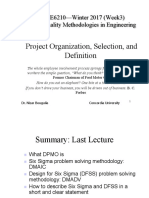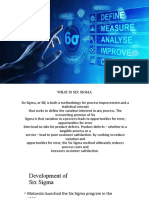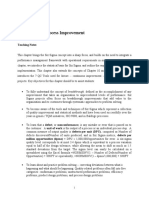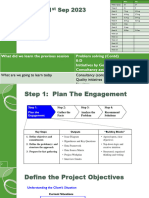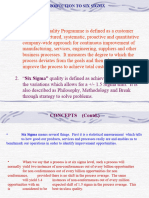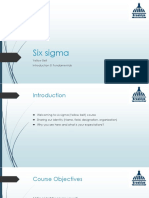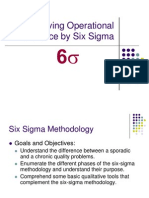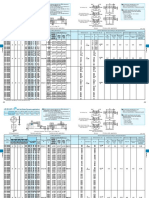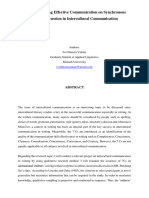Chapter 9
Process Improvement
and Six Sigma
MANAGING FOR QUALITY AND PERFORMANCE EXCELLENCE, 10E, © 2017 Cengage Publishing,
�Breakthrough
…the accomplishment of any improvement that
takes an organization to unprecedented levels of
performance.
Breakthrough attacks chronic losses or, in
Deming’s terminology, common causes of
variation.
Process improvement methodologies and tools
provide the foundation for breakthrough as well
as modern Six Sigma approaches.
2
�Process Improvement Methodologies
Redefining and analyzing the problem: Collect and organize
information, analyze the data and underlying assumptions,
and reexamine the problem for new perspectives, with the
goal of achieving a workable problem definition.
Generating ideas: “Brainstorm” to develop potential
solutions.
Evaluating and selecting ideas: Determine whether the ideas
have merit and will achieve the problem solver’s goal.
Implementing ideas: Sell the solution and gain acceptance
by those who must use them.
3
�4
�Evolution of the Deming Cycle
Walter Shewhart: specification, production, and
inspection for mass production.
These steps correspond to the scientific method of
hypothesizing, carrying out an experiment, and testing
the hypothesis.
“Deming Wheel”
1. Design the product with appropriate tests.
2. Make the product and test in the production line and in the
laboratory.
3. Sell the product.
4. Test the product in service and through market research.
Japanese Implementation: Plan-Do-Check-Act
5
�Plan (1 of 2)
1. Define the process: its start, end, and what it does.
2. Describe the process: list the key tasks performed and
sequence of steps, people involved, equipment used,
environmental conditions, work methods, and
materials used.
3. Describe the players: external and internal customers
and suppliers, and process operators.
4. Define customer expectations: what the customer
wants, when, and where, for both external and internal
customers.
5. Determine what historical data are available on process
performance, or what data need to be collected to
better understand the process.
6
�Plan (2 of 2)
6. Describe the perceived problems associated with the
process; for instance, failure to meet customer
expectations, excessive variation, long cycle times, and
so on.
7. Identify the primary causes of the problems and their
impacts on process performance.
8. Develop potential changes or solutions to the process,
and evaluate how these changes or solutions will
address the primary causes.
9. Select the most promising solution(s).
7
�Do
1. Conduct a pilot study or experiment to
test the impact of the potential
solution(s).
2. Identify measures to understand how
any changes or solutions are successful in
addressing the perceived problems.
8
�Study
1. Examine the results of the pilot study
or experiment.
2. Determine whether process
performance has improved.
3. Identify further experimentation that
may be necessary.
9
�Act
1. Select the best change or solution.
2. Develop an implementation plan: what
needs to be done, who should be involved,
and when the plan should be accomplished.
3. Standardize the solution, for example, by
writing new standard operating procedures.
4. Establish a process to monitor and control
process performance.
10
�11
�12
�Creative Problem Solving
Creativity is seeing things in new or novel ways.
Creative Problem Solving Process
Understanding the “Mess”– identify symptoms
Finding Facts – gather data; operational definitions
Identifying Specific Problems – find the root cause
Generating Ideas – brainstorming
Developing Solutions – evaluate ideas and proposals
Implementing Solutions – make the solution work
13
�Custom Improvement Methodologies
FADE: focus, analyze, develop, and execute.
DRIVE—Define the problem, Recognize the cause,
Identify the solution, Verify the actions, and Evaluate
the results. (Park Place Lexus)
Some organizations embed the Deming cycle within a
broader framework.
14
�15
�DMAIC Methodology
1. Define
2. Measure
3. Analyze
4. Improve
5. Control
16
�Six Sigma
…a business improvement approach that seeks to find
and eliminate causes of defects and errors in
manufacturing and service processes by focusing on
outputs that are critical to customers and a clear
financial return for the organization.
The term six sigma is based on a statistical measure
that equates to 3.4 or fewer errors or defects per
million opportunities (dpmo).
17
�Principles of Six Sigma (1 of 2)
1. Think in terms of key business processes and customer
requirements with a clear focus on overall strategic
objectives.
2. Focus on corporate sponsors responsible for
championing projects, support team activities, help to
overcome resistance to change, and obtain resources.
3. Emphasize such quantifiable measures as dpmo that can
be applied to all parts of an organization: manufacturing,
engineering, administrative, software, and so on.
18
�Principles of Six Sigma (2 of 2)
4. Ensure that appropriate metrics are identified early in the
process and that they focus on business results, thereby
providing incentives and accountability.
5. Provide extensive training followed by project team
deployment to improve profitability, reduce non-value-added
activities, and achieve cycle time reduction.
6. Create highly qualified process improvement experts (“Green
Belts,” “Black Belts,” and “Master Black Belts”) who can apply
improvement tools and lead teams.
7. Set stretch objectives for improvement.
19
�Differences Between Six Sigma and TQM
TQM is based largely on worker empowerment and teams; Six
Sigma is owned by business leader champions.
TQM activities generally occur within a function, process, or
individual workplace; Six Sigma projects are truly cross-
functional.
TQM training is generally limited to simple improvement
tools and concepts; Six Sigma focuses on a more rigorous and
advanced set of statistical methods and DMAIC
methodology.
TQM is focused on improvement with little financial
accountability; Six Sigma requires a verifiable return on
investment and focus on the bottom line.
20
�Types of Quality Problems
Conformance problems are defined by unsatisfactory Six Sigma
performance by a well-specified system.
Efficiency problems result from unsatisfactory
Lean tools
performance from the standpoint of stakeholders other
than customers.
Unstructured performance problems result from Creative
unsatisfactory performance by a poorly specified system. thinking
Product design problems involve designing new products
that better satisfy user needs—the expectations of Special tools
customers that matter most to them. (Ch. 7)
Process design problems involve designing new
Combined
processes or substantially revising existing processes. approaches
21
�Project Management and Organization
Projects are the vehicles that are used to organize and
to implement Six Sigma.
The Project Management Body of Knowledge
(PMBOK), developed by the Project Management
Institute, defines 69 tools that every project manager
should master.
Achieving professional certification in project
management can significantly assist Six Sigma efforts.
22
�Six Sigma Teams
Champions: Senior-level managers who promote and lead the
deployment of Six Sigma in a significant area of the business.
Master Black Belts: Full-time Six Sigma experts who are responsible for
Six Sigma strategy, training, mentoring, deployment, and results.
Black Belts: Fully-trained Six Sigma experts with extensive technical
training who perform much of the technical analysis required in Six
Sigma projects, usually on a full-time basis.
Green Belts: Functional employees who are trained in introductory Six
Sigma tools and methodology and work on projects on a part-time
basis, assisting Black Belts while developing their own knowledge and
expertise.
Team Members: Individuals from various functional areas who support
specific projects.
23
�Factors in Six Sigma Project
Selection
Financial return, as measured by costs associated
with quality and process performance, and impacts on
revenues and market share
Impacts on customers and organizational
effectiveness
Probability of success
Impact on employees
Fit to strategy and competitive advantage
24
�Return on Quality (ROQ)
…balancing quality costs against expected revenue
gains
Principles
Quality is an investment
Quality efforts must be made financially accountable.
It is possible to spend too much on quality.
Not all quality expenditures are equally valid.
25
�26
�27
�Toyota A3 Report
1. Theme, which succinctly states the problem being addressed.
2. Background, which contains a description of all pertinent information
needed to understand the scope of the problem.
3. Current condition, which deals with developing an understanding of
the process using a value-stream map.
4. Cause analysis, which focuses on determining the cause of the
problem.
5. Target condition, which specifies possible improvement ideas that
could solve the problem.
6. Implementation plan, which identifies the steps that need to be
accomplished in order to achieve the improvements.
7. Follow-up, which lists activities that will need to be completed after
implementation along with the results of the implementation.
28
�29
�Define
Describe the problem in operational terms
Drill down to a specific problem statement (project
scoping)
Apply Pareto analysis
Identify the process
Use a SIPOC diagram
Develop a project charter to include
A simple project definition, the project objective, the project
team and sponsor, the customers and CTQs on which the
project focuses, existing measures and performance
benchmarks, expected benefits and financial justification, a
project timeline, and the resources needed.
30
�Pareto Analysis
A Pareto distribution is one in which the characteristics
observed are ordered from largest frequency to smallest.
A Pareto diagram is a graphical description of a Pareto
distribution.
31
�32
�33
�Measure
Focus on understanding process performance and
collecting the data necessary for analysis.
Key data collection questions
What questions are we trying to answer?
What type of data will we need to answer the question?
Where can we find the data?
Who can provide the data?
How can we collect the data with minimum effort and
with minimum chance of error?
Operational definitions – clarify performance measures
34
�Y = f(X)
Six Sigma uses the notion of a function in mathematics to
portray the relationship between process performance and
customer value
Y is the set of CTQs and X represents the set of critical input
variables that influence Y.
35
�Check Sheets
…special types of data collection forms in which the
results may be interpreted on the form directly
without additional processing
36
�37
�38
�39
�Analyze
Analyzing a problem starts with a
fundamental understanding of the process
typically accomplished through detailed process
mapping, expanding on the SIPOC diagram that
is developed in the Define phase.
Value stream map - highlights value-added
versus non-value-added activities, and include
times that activities take.
Value stream maps are an important tool in lean
thinking
40
�Why Defects, Errors, or Excessive Variation
Occur (1 of 2)
A lack of knowledge about how a process works, which is
particularly critical if different people perform the process.
Such lack of knowledge results in inconsistency and increased
variation in outputs.
A lack of knowledge about how a process should work,
including understanding customer expectations and the goal
of the process
A lack of control of materials and equipment used in a process
Inadvertent errors in performing work
41
�Why Defects, Errors, or Excessive Variation
Occur (2 of 2)
Waste and complexity, which manifest themselves in many ways,
such as unnecessary steps in a process and excess inventories
Hasty design and production of parts and assemblies; poor design
specifications; inadequate testing of incoming materials and
prototypes
•Failure to understand the capability of a process to meet
specifications
Lack of training
Poor instrument calibration and testing
Inadequate environmental characteristics such as light,
temperature, and noise
42
�Root Cause Analysis
Root cause -“that condition (or interrelated set of conditions)
having allowed or caused a defect to occur, which once corrected
properly, permanently prevents recurrence of the defect in the
same, or subsequent, product or service generated by the process.”
Root cause analysis is an approach using statistical, quantitative, or
qualitative tools to identify and understand the root cause.
“5 Why” technique - forces one to redefine a problem statement as
a chain of causes and effects to identify the source of the symptoms
by asking why, ideally five times.
Cause-and-effect diagram is a simple graphical method for
presenting a chain of causes and effects and for sorting out causes
and organizing relationships between variables.
Scatter diagram - the graphical component of regression analysis.
43
�44
�45
�Improve
Generate ideas for removing or resolving the problem and
improve the performance measures and CTQs.
Brainstorming – a group problem-solving procedure for
generating a large number of ideas through combination and
enhancement of existing ideas.
Checklists to spawn new ideas.
Evaluation and selection
Scoring models to assess possible solutions against important
criteria such as cost, time, quality improvement potential,
resources required, effects on supervisors and workers, and
barriers to implementation such as resistance to change or
organizational culture.
46
�Control
Maintain the improvements, which includes putting
tools in place to ensure that the key variables remain
within the maximum acceptable ranges under the
modified process.
establishing the new standards and procedures,
training the workforce, and
instituting controls to make sure that improvements do not
die over time using checklists, status reviews, or control
charts.
47
�Lean Tools
Lean production refers to approaches that originated
at the Ford Motor Company in the early 1900s, but
which were refined and modernized by the Toyota
Motor Corporation later in the century.
Lean approaches focus on the elimination of waste in
all forms, including defects requiring rework,
unnecessary processing steps, unnecessary movement
of materials or people, waiting time, excess inventory,
and overproduction.
48
�Tools of Lean Production
The 5S’s: seiri (sort), seiton (set in order), seiso
(shine), seiketsu (standardize), and shitsuke (sustain).
Visual controls.
Efficient layout and standardized work.
Pull production.
Single minute exchange of dies (SMED).
Total productive maintenance.
Source inspection.
Continuous improvement.
49
�Lean Six Sigma
…an integrated improvement approach to improve
goods and services and operations efficiency by
reducing defects variation, and waste.
Lean production addresses visible problems in
processes, for example, inventory, material flow, and
safety.
Six Sigma is more concerned with less visible problems,
for example, variation in performance.
50
�Lean Six Sigma Metrics in Services
Accuracy
Cycle time
Cost
Customer satisfaction
51
�The End
52


